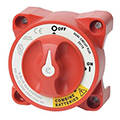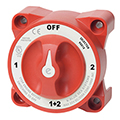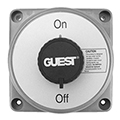Categories
- Wire & Cable
- Multi-conductor & Signal Cable
- Battery Cable Assemblies
- Terminals and Connectors
- Electrical Parts
- Electrical Tools
- ID Products
- Wire Management
- Tape & Sealant
- Mounting Panels & Panel Blanks

Need Help?
Click HereGet a Business Account
Apply HereBattery Switches
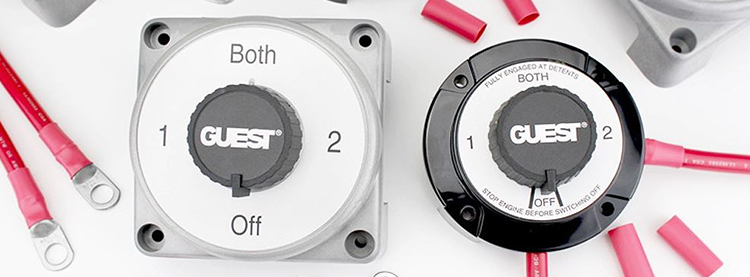
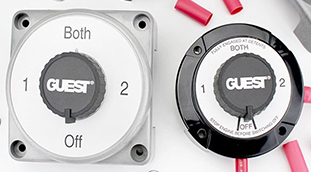
What are battery switches?
Battery switches are specialized electrical devices engineered to control the connection between a battery (or battery bank) and a vessel’s electrical system. In marine environments, they serve critical functions such as switching between multiple battery banks, combining banks for emergency starts, or fully isolating a battery to prevent unwanted power drain or hazards.
Pacer supplies an extensive range of marine-grade battery switches including the E-Series, M-Series, Guest HD series, and universal models, ensuring compatibility with virtually any vessel configuration. Whether your system demands high-amperage handling, ignition protection, or advanced safety functions, we stock purpose-built solutions to match the requirements of your application.
"We stock purpose-built solutions to match the requirements of your application."
What safety features do battery switches offer?
Marine battery switches are more than just on/off controls; they are safety-critical components. Our battery switches offer several safety features that are built into the switch body itself. These engineered safeguards not only protect the crew and vessel but also meet the stringent demands of modern marine compliance standards.
Fully Sealed and Enclosed Conductive Surfaces
No exposed live parts beyond the secure connection studs, minimizing the risk of accidental operator contact.
Protected, Durable, Compliant Connection Points
Safe whether surface-mounted or panel-mounted on a vessel, meeting the ABYC safety guidelines.
Battery Isolation in Emergencies
Capable of instantly disconnecting power to help contain electrical fires or prevent current from fueling a blaze.
What advantages do battery switches offer?
Beyond the safety features mentioned above, the battery switches we carry offer a host of advantages, such as advanced multi-stage charging, a durable aluminum case to prevent damage, a one-piece terminal stud designed to not loosen over time, multiple mounting options, and a “make or break” contact design. These features make our switches suitable for the most challenging marine environments, where reliability is non-negotiable. How many other battery switches give you the choice between surface mount, rear mount, or even front panel mount? The bottom line is that these switches are designed to handle the toughest environments and, as such, offer advantages you don't find elsewhere.
![]()
![]()
![]()
![]()
![]()
Where are battery switches implemented?
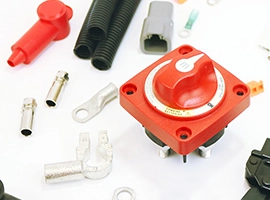
Battery switches are built to handle the toughest marine applications.
Battery switches are implemented in marine applications where the ignition system needs a high degree of protection. One thing that makes battery switches so useful is that they allow you to isolate the battery in case of a fire. All our battery switches are ideal while installing new equipment as well as when handling replacement parts. All you will need to properly install a battery switch are the correct tools and battery cable assemblies. Just so you know, the ABYC requires that all boats with cranking amps over 800 have a battery switch onboard. Even though we touched on the basics, let us take a deeper look at where you would use a battery switch.
Where would I use battery switches?
Battery switches are designed for use in environments where you would need to switch between battery banks or combine battery banks. What sets these battery switches apart from other types is the fact that they are not only built for safety but that they are built to handle the toughest environments out there. This makes them ideal for use in the marine environment. They can be installed in a multitude of locations and are even known for their ease of installation.

What is the difference between these battery switches?
Each type of battery switch that we carry is designed with a specific application in mind. Some may be a single circuit while others may be a dual circuit. The biggest difference to pay attention to is the series. We carry the E-series, M series, Guest HD series, as well as other Guest battery switches. Below we will take a quick look at each of the different series and what separates them from the other series.
The biggest difference with the E-Series is that they are designed for use in applications that require 350 amps of continuous power. They also offer 600 amps of intermittent power. They are commonly used with small gasoline engines, outboards, or diesel engines. The E-series are known as compact high-amperage switches that offer vapor/ignition protection.
The M-series of battery switches are designed for applications that require 300 amps of continuous power. They additionally offer 500 amps of intermittent power. Similar to the E-series, the M-series is commonly used in small gasoline engines, outboards, or diesel applications. So, the main thing to consider when looking at these switches is the amperage. Pay careful attention to the needs of your specific applications.
Guest HD series of battery switches are used in applications that require either 360 amps of continuous power, 450 amps, or 600 amps depending on the type of HD series battery switch you select. Important note: some of the HD series battery switches offer AFD (alternating field disconnect) so if you are looking for a battery switch with AFD, then these are the ideal choice.
These Guest battery switches are for use in applications that call for 230 amps of continuous power. They additionally offer 345 amps of momentary power. These are clearly the battery switches designed with the lowest amperages in mind. These battery switches offer the same easy switching that comes with the other types of battery switches listed here.
| Series | Amperage | Feature 1 | Feature 2 |
| E-Series | 350 A continuous, 600 A intermittent | Compact, high-amperage design | Vapor/ignition protection for gasoline or diesel applications |
| M-Series | 300 A continuous, 500 A intermittent | Similar to E-Series with slightly lower amperage capacity | Ideal for smaller gasoline, outboard, or diesel systems |
| Guest HD Series | Options for 360 A, 450 A, or 600 A continuous | Some models include AFD (Alternator Field Disconnect) for safe alternator protection during switching | Designed for high-demand systems |
| Guest Universal Series | 230 A continuous, 345 A momentary | Entry-level option for lower amperage systems | Maintains the same ease of operation as higher-capacity models |
Why choose Pacer?
With over four decades in the marine electrical industry, Pacer is trusted by some of the world’s largest boatbuilders for quality, expertise, and dependability. Every product undergoes rigorous testing—if we wouldn’t install it in our own vessels, we won’t sell it. Our reputation is built on delivering marine-optimized components that perform flawlessly in real-world conditions.



